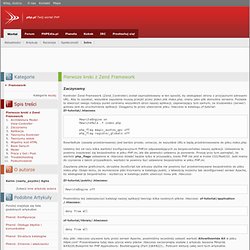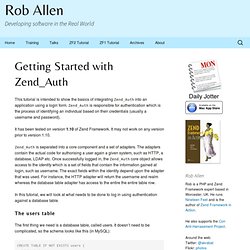

Zend Auth Login. Zend Framework - Przewodnik Programisty - Polski - zfdes.com. Zaczynamy / Pierwsze kroki z Zend Framework / Framework / Artykuły / Wortal / Home - php.pl. Proponuję alternatywęWtorek 09 Luty 2010 1:23:49 pm - siema1980 Proponuję zapoznać się z moim kursem na temat ZF, jest to blog na temat podstaw i myślę, że wszystkim początkującym się przyda - szczególnie tym którzy nie wiedzą jak w ogóle postawić pierwsze kroki w używaniu tej technologii.

Zapraszam serdecznie. Zmiany w stosunku do ZF 1.0Sobota 07 Lipiec 2007 11:41:02 am - elem84 $config->db->config->asArray() ta część jest nieaktualna dla wersji 1.0 należy ją zastąpić $config->db->config->toArray() ZendPoniedziałek 26 Luty 2007 10:15:26 am - mrm czy na pewno to działa ? Szkoła kononowiczaPoniedziałek 29 Styczeń 2007 4:03:22 am - MARIO77 cytat: "Zend Framework rezerwuje również domyślny controller i nie powinno być dla nas niespodzianką, że też się nazywa się on index. " Creating Form Elements Using Zend_Form_Element. A form is made of elements that typically correspond to HTML form input.

Zend_Form_Element encapsulates single form elements, with the following areas of responsibility: validation (is submitted data valid?) Capturing of validation error codes and messages filtering (how is the element escaped or normalized prior to validation and/or for output?) Rendering (how is the element displayed?) Metadata and attributes (what information further qualifies the element?) The base class, Zend_Form_Element, has reasonable defaults for many cases, but it is best to extend the class for commonly used special purpose elements. Plugin Loaders Zend_Form_Element makes use of Zend_Loader_PluginLoader to allow developers to specify locations of alternate validators, filters, and decorators.
The following loader types are used with the various plugin loader methods: 'validate', 'filter', and 'decorator'. The methods used to interact with plugin loaders are as follows: Filters Let's see some examples: Zend_Db_Table. Introduction The Zend_Db_Table class is an object-oriented interface to database tables.

It provides methods for many common operations on tables. The base class is extensible, so you can add custom logic. The Zend_Db_Table solution is an implementation of the » Table Data Gateway pattern. The solution also includes a class that implements the » Row Data Gateway pattern. Using Zend_Db_Table as a concrete class As of Zend Framework 1.9, you can instantiate Zend_Db_Table. Example #1 Declaring a table class with just the string name Zend_Db_Table::setDefaultAdapter($dbAdapter);$bugTable = new Zend_Db_Table('bug'); The above example represents the simplest of use cases.
Defining a Table Class For each table in your database that you want to access, define a class that extends Zend_Db_Table_Abstract. Defining the Table Name and Schema Declare the database table for which this class is defined, using the protected variable . Tutorial: Getting Started with Zend_Auth. This tutorial is intended to show the basics of integrating Zend_Auth into an application using a login form.

Zend_Auth is responsible for authentication which is the process of identifying an individual based on their credentials (usually a username and password). It has been tested on version 1.10 of Zend Framework. It may not work on any version prior to version 1.10. Zend_Auth is separated into a core component and a set of adapters. The adapters contain the actual code for authorising a user again a given system, such as HTTP, a database, LDAP etc. In this tutorial, we will look at what needs to be done to log in using authentication against a database table. The users table The first thing we need is a database table, called users. CREATE TABLE IF NOT EXISTS users ( id int(11) NOT NULL AUTO_INCREMENT, username varchar(50) NOT NULL, password varchar(50) NOT NULL, salt varchar(50) NOT NULL, role varchar(50) NOT NULL, date_created datetime NOT NULL, PRIMARY KEY (id) ) < ? Authenticating.